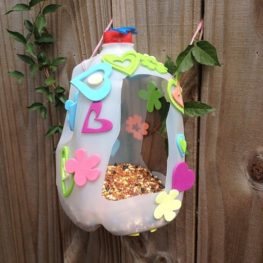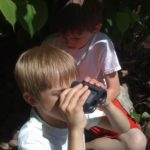 An activity to help you learn more about birds in your own back yard
An activity to help you learn more about birds in your own back yard
You will collect data to answer a scientific question and use this information to improve your own backyard habitat. Created By Nancy Yard, RHA Volunteer and Educator
Level: pre-K through Elementary
Duration: 14 to 30 days
Setting: This lesson is designed to take place in your own back yard. Depending on placement of the feeding station, it can be done from the window.
Materials:
- A birdfeeder (plastic milk jug, half gallon milk carton, old cookie sheets or a plastic bin with holes for drainage)
- Use your nature journal for data collection, or record data using scrap paper.
- Birdseed (sunflower seeds, thistle seed, bird seed mix)
Background Information: You will create a bird feeding station to determine if birds in your backyard prefer to eat at a feeder or on the ground. You will count at the same time each day. Each fly-in will count as one bird so you don’t have to keep track if you are seeing the same bird. You will count the birds for a consistent period of time and tally the number of birds during the given time frame.
The Activity:
- Create one feeder that can be hung or placed at minimum of four feet above the ground from the bottom of the feeder. STEM Challenge: try to create a feeder to last for the duration of the study. Be creative with items found in your home.
- Select bird seed and use the same feed in the feeder as on the ground. Fill your feeder and spread seed on the ground under the feeder.
- Select a time to observe the feeding station each day. Time duration should be for five minutes per observation period. You can choose to observe the feeding activity once or twice a day. Be consistent and record the times.
- Record the weather during each observation. This can be done by writing or drawing a sun, cloud/sun, or cloud. Challenge: record the temperature each time.
- Create two columns: one labeled Feeder and one labeled Ground. Tally the birds as they come to the feeder or ground. Remember: Each visit is one tally. If a bird goes from feeder to ground, they count in both columns.
- If you choose to journal you may wish to sketch the birds that you are observing.
- Continue your observations for a minimum of 14 days.
- Analyze your data to determine the amount of visits during the total observation period.
Do some birds prefer the ground or the feeder? What do you notice about the birds at the feeder? What do you notice about the birds feeding on the ground? Does weather impact bird feeding habits at your station? If you are watching at two different times of day does the time of day impact the amount of birds or types of birds, you see? Based on the habits of your birds how might you change your yard to encourage more birds to visit/feed?
 STEM Challenge: Create a bird feeder that allows the bird to fly in, dine, and fly out the opposite side.
STEM Challenge: Create a bird feeder that allows the bird to fly in, dine, and fly out the opposite side.
Wrap Up: Would you like to continue your study? Set up more stations and monitor the birds eating different seeds. Set one feeder in the open and one near cover.
Share pictures of your original feeders with the Raritan Headwaters Community Group Facebook Page!
How did you like this activity? Please share any questions, comments, or photos that you and your child have on the Raritan Headwaters Learning Community Facebook Page!
More Raritan Headwaters Learning Resources
